Have you ever followed all the basic advice for container gardening, only to end up with struggling, inconsistent results? You’re not alone. Many gardeners find themselves frustrated when their potted plants fail to thrive, and beginner checklists don’t address the persistent issues of watering, soil, and long-term health. This isn’t just another list of basic tips. This is a comprehensive guide to understanding the “why” behind the “how,” designed to transform your approach from guesswork to mastery.
At Green Thumb Chronicles, we draw from a legacy of horticultural knowledge stretching back to 1792 with The Old Farmer’s Almanac. We understand the science and art of making things grow, no matter the space. We’re here to help you move beyond the basics and cultivate the thriving container garden you’ve always wanted.
The foundations of container gardening defined
What is container gardening at its core?
Container gardening is the practice of growing plants, including ornamentals and edibles, exclusively in containers or pots rather than in the ground. It is a versatile system that creates a completely controlled environment for a plant’s entire lifecycle. At its heart, it involves managing a contained ecosystem, where you are responsible for everything from the soil composition and moisture levels to the nutrient availability that a plant needs to flourish.
The key benefits for modern living

One of the greatest appeals of container gardening is its adaptability. It offers elegant solutions to many modern horticultural challenges.
- Solves the ‘no space’ problem: It’s the perfect solution for apartments, patios, balconies, and small yards where in-ground gardening isn’t an option.
- Provides total soil control: You can create the perfect soil environment for specific plants, like crafting acidic soil for blueberries, a feat that is nearly impossible in native garden soil.
- Enhances accessibility: Raised pots and containers make gardening accessible and enjoyable for people with mobility issues or those who have difficulty bending and kneeling.
- Reduces weed and pest problems: A contained, elevated environment is far easier to manage and protect from common weeds and soil-borne pests.
- Offers portability and flexibility: You can move plants to optimize their sun exposure throughout the day, bring tender plants indoors for the winter, or simply rearrange your outdoor space to fit your mood.
Container vs. traditional gardening: critical differences
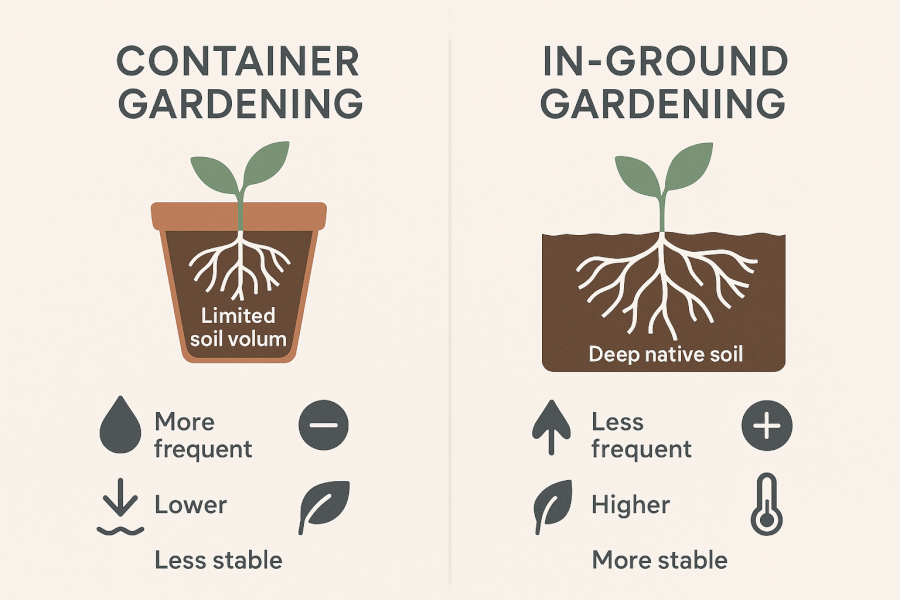
Understanding the fundamental differences between growing in pots and in the earth is the first step toward mastery. A container is a closed system with unique demands.
| Feature | Container Gardening | In-Ground Gardening |
|---|---|---|
| Watering | Dries out very quickly; requires frequent, diligent watering. | Soil retains moisture longer; less frequent watering needed. |
| Soil | Requires a light, airy, well-draining “potting mix.” | Uses native garden soil, which is dense and heavy. |
| Nutrients | Limited supply; nutrients are depleted and wash out, requiring regular fertilization. | Vast reservoir of nutrients; plants can extend roots to find more. |
| Temperature | Soil heats up and cools down rapidly, potentially stressing roots. | Ground temperature is stable, insulating roots from extremes. |
Your essential toolkit: choosing the right containers, soil, and plants
Success starts with the right materials. Each component—the pot, the soil, and the plant itself—plays a critical role in the health of your miniature ecosystem.
How to choose the perfect container: size, material, and drainage

When selecting a pot, function should always come before fashion.
-
Size matters most: A pot that is too small is a common mistake that restricts root growth, causes the soil to dry out too quickly, and leads to a stressed, underperforming plant. Always choose a container that accommodates the plant’s mature size.
- Herbs & Lettuce: 1-2 gallon pots
- Peppers & Bush Beans: 3-5 gallon pots
- Tomatoes & Zucchini: 5-10 gallon pots
-
Material comparison:
- Terracotta (clay): Porous and classic, it allows air and water to move through the sides, which helps prevent root rot. However, it also dries out very quickly.
- Plastic & Glazed Ceramic: Lightweight and available in many styles, these non-porous materials are excellent at retaining moisture, making them ideal for thirsty plants.
- Fabric Pots: Offer superior aeration and drainage, preventing roots from circling and promoting a healthier, more fibrous root system.
- Drainage is non-negotiable: No matter the size or material, every container must have drainage holes. If a decorative pot lacks them, use it as a cachepot (a decorative sleeve) by placing a functional pot with holes inside it.
The great soil debate: why potting mix is your only option
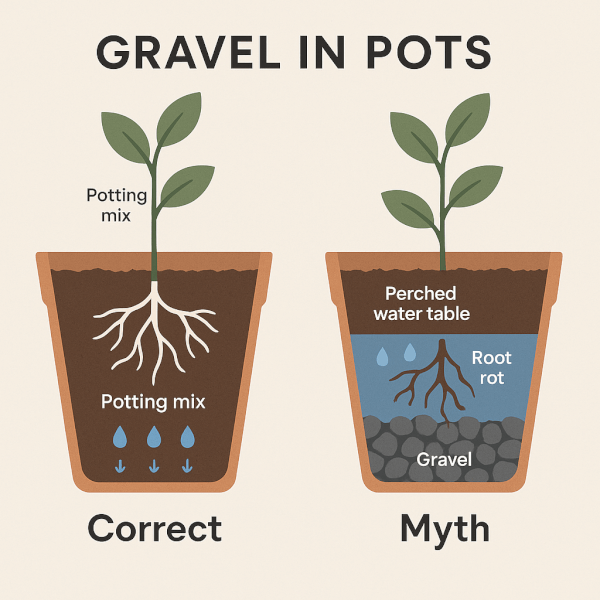
You cannot use soil from your garden in a pot. It is too dense and heavy, and it will quickly compact, choking off the oxygen and water that plant roots need to survive.
The only choice for containers is a quality potting mix. This is a specially formulated, soil-less medium, typically made from a blend of peat moss, coconut coir, perlite, and vermiculite. This mix is designed to be light and fluffy, holding a perfect balance of moisture and air for healthy root development.
Furthermore, it’s crucial to debunk a persistent gardening myth: adding a layer of gravel or rocks to the bottom of a pot does not improve drainage. In fact, it does the opposite. As horticulturalists at the University of Illinois Extension have demonstrated, this practice creates a “perched water table” that elevates the waterlogged zone, keeping the soil wetter and dramatically increasing the risk of root rot.
Curated plant selections for thriving container gardens
For the best results, choose plant varieties that are specifically bred for compact growth. Look for terms like ‘dwarf,’ ‘patio,’ ‘bush,’ or ‘container’ in the plant’s name.
- Vegetables: ‘Patio Princess’ tomatoes, bush beans, peppers, lettuce greens, and even short-rooted carrots like ‘Paris Market’ if the container is deep enough.
- Herbs: Almost all common herbs thrive in pots. Basil, mint, rosemary, thyme, parsley, and oregano are excellent choices.
- Ornamentals: Petunias, geraniums, coleus, heuchera, and calibrachoa provide long-lasting color and texture.
Mastering core care: watering, feeding, and maintenance
Consistency is key. Once your containers are planted, mastering these three core skills will ensure they remain healthy and productive all season long.
The art of watering potted plants
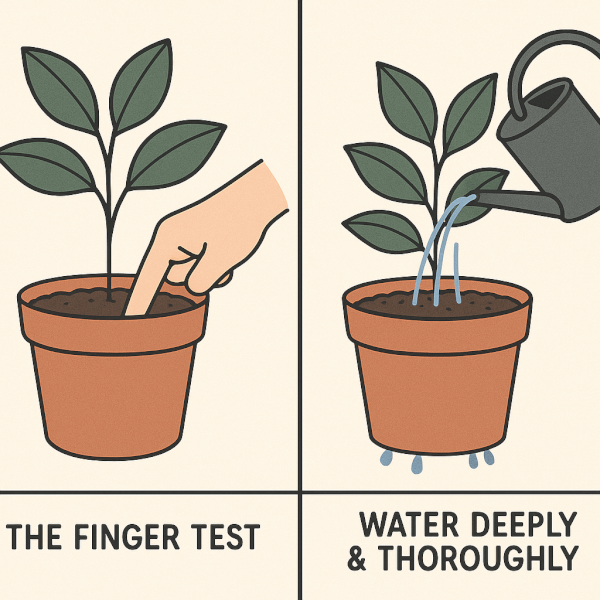
The most common challenge in container gardening is mastering the nuances of watering.
- Ditch the schedule, use the ‘finger test’: Instead of watering daily, check your plants first. Insert your finger into the top 1-2 inches of soil. If it feels dry, it’s time to water. If it’s moist, wait another day. I’ve learned the hard way that a wilting tomato plant in the afternoon sun might not be thirsty—it could just be conserving water. The finger test is the only way to know for sure.
- Water deeply and thoroughly: When you do water, do it well. Pour water over the entire soil surface until it runs freely from the drainage holes at the bottom. This ensures the entire root ball is hydrated.
- Avoid shallow, frequent watering: Lightly sprinkling your plants every day encourages weak, shallow roots that are vulnerable to heat and drought.
For busy gardeners or exceptionally thirsty plants, self-watering planters can be an excellent tool for maintaining consistent moisture.
A simple guide to fertilizing your container garden
Plants in pots have a limited amount of soil and nutrients to draw from. Every time you water, some of those nutrients are washed out of the pot. This makes regular fertilization essential.
- Slow-release granules: These are mixed into the potting soil at planting time and slowly release nutrients over several months.
- Liquid fertilizer: This is diluted with water and applied every 2-4 weeks during the growing season. It provides a quick boost of nutrients that are immediately available to the plant.
A simple and effective strategy is to start with a potting mix that already contains a slow-release fertilizer, then supplement with a balanced liquid fertilizer mid-season for heavy feeders like tomatoes and petunias.
Designing for success: the ‘thriller, filler, spiller’ method
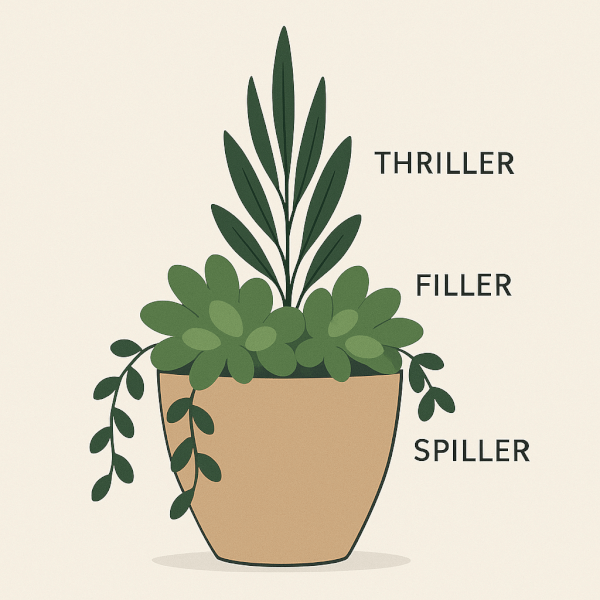
To create visually stunning mixed containers, use this classic and foolproof design rule. For a balanced arrangement, always choose plants that share similar light and water requirements.

- Thriller: A tall, upright, and showy plant that goes in the center or back of the container to provide a vertical element. (e.g., a dracaena spike, coleus, or salvia).
- Filler: Mounding plants that surround the thriller and fill the space, adding mass and color. (e.g., petunias, geraniums, or marigolds).
- Spiller: Trailing plants that cascade over the sides of the pot, softening the edges and adding a sense of abundance. (e.g., sweet potato vine, calibrachoa, or creeping jenny).
Troubleshooting common container gardening challenges
Even with the best care, problems can arise. Here’s how to diagnose and solve the most common issues.
Solving the #1 problem: drainage and root rot
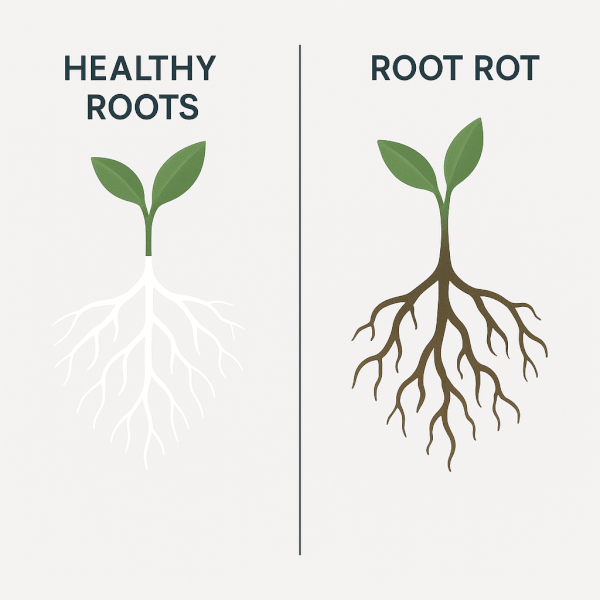

The symptoms of overwatering and poor drainage are often mistaken for underwatering. Look for yellowing leaves (especially the lower ones), wilting even when the soil is wet, and stunted growth. This is caused by roots sitting in waterlogged soil, which deprives them of oxygen and leads to root rot.
Prevention is the only cure. Revisit the fundamentals: ensure your pot has ample drainage holes and that you are using a high-quality, fast-draining potting mix. If you suspect root rot, gently remove the plant, trim away any brown, mushy roots with clean shears, and repot in fresh, dry soil. Water very sparingly until you see signs of new growth.
Identifying and managing common pests and diseases
- Common Pests: Aphids, spider mites, and whiteflies often target container plants. Check the undersides of leaves for them.
- Solutions: Always start with the simplest, least toxic method. A strong spray of water from a hose can often dislodge them. If they persist, move on to an insecticidal soap or neem oil spray.
- Common Diseases: Powdery mildew, a white, dusty coating on leaves, is frequent.
- Solutions: This is often a sign of poor air circulation. Give plants more space and try to water the soil directly, keeping the foliage dry. Neem oil can also act as a preventative fungicide.
Understanding nutrient deficiencies
Based on diagnostic guides from agricultural extensions, these are the most common signs to look for if you suspect a nutrient issue.
| Symptom | Likely Deficiency | Solution |
|---|---|---|
| Yellowing of older, lower leaves | Nitrogen (N) | Apply a balanced liquid fertilizer. |
| Stunted growth; purple-tinged leaves | Phosphorus (P) | Use a fertilizer with a higher middle number (P). |
| Yellowing along the edges of leaves | Potassium (K) | Use a balanced fertilizer or one rich in potassium. |
In most cases, a single dose of a balanced, all-purpose liquid fertilizer will correct the imbalance and restore your plant’s vigor.
Key takeaways for container gardening mastery
- Foundation First: Always use a quality potting mix, never garden soil. Ensure every single pot has drainage holes.
- Master Watering: Ditch the schedule and use the ‘finger test.’ Water deeply and less frequently rather than shallowly and often.
- Feed Your Plants: Container plants are heavy feeders. Use a combination of slow-release and liquid fertilizers for the best results.
- Smart Selection: Choose plant varieties specifically bred for containers and use the ‘Thriller, Filler, Spiller’ method for beautiful, healthy arrangements.
Frequently asked questions about container gardening
What is the definition of container gardening?
Container gardening is the practice of growing plants in containers or pots instead of in the ground, allowing for a controlled and portable growing environment.
What are the main advantages of container gardening?
The main advantages are saving space, having complete control over soil quality, improved accessibility, fewer weed and pest issues, and the flexibility to move plants as needed.
What do you need to start a container garden?
To start, you need three essential items: a container with drainage holes, a quality potting mix (not garden soil), and plants that are well-suited for the container’s size.
Can you grow any plant in a container?
While you can technically grow almost any plant in a container, success depends on choosing a pot large enough to accommodate the plant’s mature root system. For best results, choose dwarf or patio varieties of larger plants.
How do you ensure good drainage in container gardening?
You ensure good drainage by using a pot with multiple drainage holes and filling it with a well-aerated potting mix. Avoid adding a layer of gravel to the bottom, as this can actually hinder drainage and promote root rot.
Conclusion: cultivate your thriving container garden
You’ve now moved far beyond the simple meaning of container gardening. You understand that success comes not from a rigid set of rules, but from thoughtfully managing the unique, controlled ecosystem that exists within each pot. By mastering the fundamentals of soil, watering, and feeding, and by learning to diagnose problems before they escalate, you are fully equipped to create the beautiful and productive container garden you’ve envisioned.
Ready to put these principles into practice? Explore our complete guide to container gardening for vegetables to start planning your first edible container garden today.























































